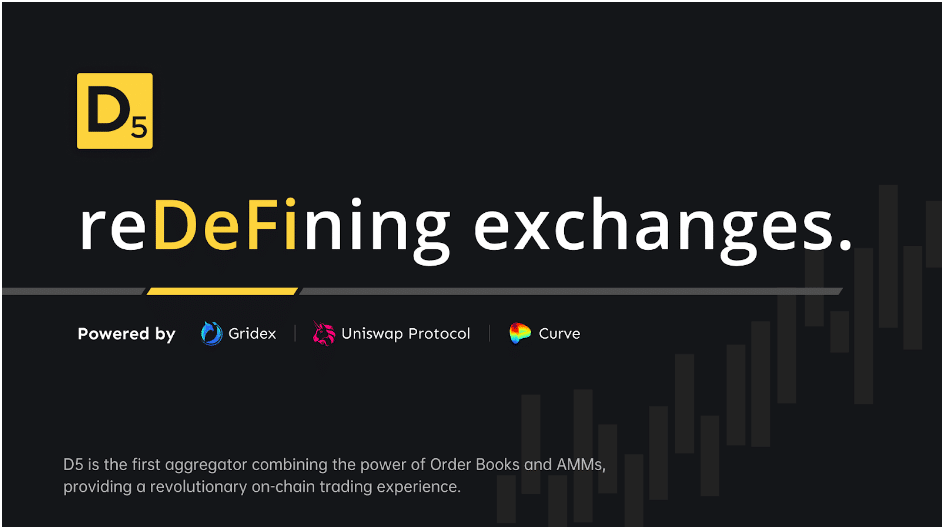Sponsored
D5 Exchange: Solving DEX issues with Gridex Protocol

The recent SEC crypto crackdown has hit many centralized exchanges (CEX). This scrutiny is drawing traders to decentralized exchanges (DEXs). However, insufficient liquidity, impermanent loss, limited trading functions, and high gas fees may make it difficult for users to migrate.
The first decentralized liquidity aggregator with order book and AMM mechanisms is Gridex Protocol-based D5 Exchange, which solves DEX issues by offering CEX-like trading.
The rise of the DEX
In November 2022, the FTX collapse massively damaged the credibility of CEXs. The same month, Block reported that trading volume for DEX increased 93s% to $65 billion.
Emerging DEX projects with strong technological innovation will have higher growth potential than the older players in the next bull market (such as Uniswap and SUSHI). One notable newcomer is the D5 Exchange.
Three-Pronged Approach: Liquidity Aggregation, Hybrid Trading Model, Ultimate User Experience
So, despite their loss of credibility, why can’t DEXs beat CEXs? Lack of liquidity, gas fees, and impermanent loss are some issues affecting DEXs. D5 Exchange, the first aggregator to combine order book and AMM functions, aims to revolutionize on-chain crypto trading and accelerate the transition from CeFi to DeFi.
D5 Exchange Hybrid Trading Model: AMM + Order Book
Most DEX trading execution models are either order book or AMM. Both have advantages and disadvantages.
AMMs allow trading in illiquid markets. Traders can close orders without a counterparty match, saving gas and completing transactions in one trade. However, large traders may suffer from slippage, and LPs may suffer from impermanent loss, the pool lacks liquidity. AMM-based DEX products include Uniswap and Balancer.
An advantage of order books is that traders can place limit orders and wait for them to be executed at the best price. If the market is liquid, trades can be done fast and slippage-free. They are commonly used in CEXs and are therefore known among mainstream traders. A disadvantage is that they may need multiple orders to complete, meaning high gas costs. Projects such as Injective and dYdX use order books.
D5 Exchange is the first exchange to combine the advantages of both AMM and order books and is the Ethereum ecosystem’s most liquid and dynamic DEX because its automatic router can aggregate liquidity from external DEXs like Uniswap (V2+V3) and Curve to achieve internal liquidity and the best exchange rate.
GMOB+GPLM: Innovative Dual-Model Order Book Algorithm
Gridex Protocol powers D5 Exchange order books, the first Gridex-based DEX. Only Gridex has an Ethereum order book.
Gridex’s Grid Maker Order Book (GMOB) is a major improvement over centralized platforms’ Central Limit Order Book (CLOB). On-chain CLOB requires significant resources. Semi-centralized CLOB platforms like dYdX match transactions off-chain and synchronize the results on-chain to solve this problem. This approach has systemic risks and goes against DeFi.
The GLOB model uses the “Grid Price Linear Movement” (GPLM) algorithm to achieve decentralization. based on L1 transactions – a huge improvement over L2 and off-chain DEXs. Gridex Protocol’s gas level matches CFMMs, while the GPLM algorithm doesn’t affect transaction settlement efficiency or user costs. Gridex Protocol’s gas level is comparable to or lower than Uniswap’s, which uses the AMM mechanism.
GMOB and GPLM allow D5 Exchange to offer a revolutionary on-chain trading experience. With this innovation, the Gridex Protocol is poised to lead the decentralized order book market.
Maker orders are used on Gridex, allowing traders to buy and sell orders above and below the market price. Also, maker orders can be placed at the current price, and if the market price changes, they may be filled. Only when maker orders are placed at the bid/ask price may they slightly diverge from trader expectations, but the impact is negligible.
Ultimate Usability
D5 Exchange’s UX design is comparable to CEXs; smooth, but with connecting wallets letting users trade immediately, and zero transaction slippage.
The Grid mechanism of D5 Exchange divides grids into three types based on price range granularity: 0.01%, 0.05%, and 0.3%, suitable for different tokens. Stablecoin trading pairs have low volatility, so a finer grid speeds execution. To maximize transaction fee income, Maker orders for high-volatility trading pairs should use coarser grids. The market will suggest grids for orders. Cancelling orders helps reorganize liquidity and avoid short-term losses. The D5 Exchange optimizes order execution and transaction fee income.
GDX Listing
Gridex’s native currency, GDX, was formally listed on the D5 Exchange, the first on-chain trading protocol for the Ethereum ecosystem, on March 15th. According to CoinMarketCap data, the price of GDX rocketed to $1.97 at its high, an increase of over 1,000 % from its listing price of $0.16. Furthermore, according to data from Abiscan, over 10,700 wallet addresses own some GDX. To facilitate trading on D5 Exchange, Gridex has launched trading pairs such as GDX/USDT, GDX/USDC, and GDX/GMX.
With a maximum supply of 200 million, 30% of GDX is set aside for project development and promotion, core contributors, and early investors. The other 70% is set aside for community distribution, which includes airdrops, PoS incentives, and maker awards. The maker rewards campaign began on Arbitrum One on the GDX/ETH trading pair (0.05% grid) on March 15th, 2023. The total prize pool for the maker rewards campaign is 54 million GDX.
Conclusion
In conclusion, D5 Exchange’s forward-thinking approach to combining AMM and order book models will help the DEX industry grow. The D5 Exchange does not solve all DEX industry issues, so industry builders must work together. The D5 Exchange and Gridex Protocol, leaders in the DEX industry, are developing DeFi together.
Website: https://www.d5.xyz/
Discord: https://discord.com/invite/Wcx79YhSq2
Twitter: https://twitter.com/d5exchange
GDX Maker Rewards Campaign: https://rewards.gdx.org/

